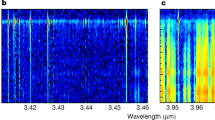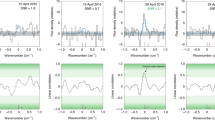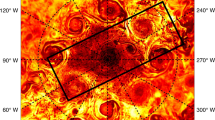Abstract
Models of Jupiter's formation and structure predict that its atmosphere is enriched in oxygen, relative to the Sun, and that consequently water clouds should be present globally near the 5-bar pressure level1,2. Past attempts to confirm these predictions have led to contradictory results3,4,5; in particular, the Galileo probe revealed a very dry atmosphere at the entry site, with no significant clouds at depths exceeding the 2-bar level6,7. Although the entry site was known to be relatively cloud-free, the contrast between the observed local dryness and the expected global wetness was surprising. Here we analyse near-infrared (around 5 µm) observations of Jupiter, a spectral region that can reveal the water vapour abundance and vertical cloud structure in the troposphere8. We find that humid and extremely dry regions exist in close proximity, and that some humid regions are spatially correlated with bright convective clouds extending from the deep water clouds to the visible atmosphere.
This is a preview of subscription content, access via your institution
Access options
Subscribe to this journal
Receive 51 print issues and online access
$199.00 per year
only $3.90 per issue
Buy this article
- Purchase on Springer Link
- Instant access to full article PDF
Prices may be subject to local taxes which are calculated during checkout


Similar content being viewed by others
References
Weidenschilling, S J. & Lewis, J. S. Atmospheric and cloud structure of the jovian planets. Icarus 20, 465–476 (1973).
Atreya, S. K. et al. A comparison of the atmospheres of Jupiter and Saturn: deep atmospheric composition, cloud structure, vertical mixing, and origin. Planet. Space Sci. 47, 1243–1262 (1999).
Drossart, P. & Encrenaz, T. The abundance of water on Jupiter from the Voyager IRIS data at 5 microns. Icarus 52, 483–491 (1982).
Bjoraker, G., Larson, H. P. & Kunde, V. The abundance and distribution of water vapor in Jupiter's atmosphere. Astrophys. J. 311, 1058– 1072 (1986).
Carlson, B. E., Lacis, A. A. & Rossow, W. B. The abundance and distribution of water vapor in the jovian troposphere as inferred from Voyager IRIS observations. Astrophys. J. 388, 648–668 (1992).
Niemann, H. B. et al. The composition of the jovian atmosphere as determined by the Galileo probe mass spectrometer. J. Geophys. Res. 103, 22831–22845 (1998).
Ragent, B. et al. The clouds on Jupiter: results on the Galileo Jupiter mission probe nephelometer experiment. J. Geophys. Res. 103 , 22891–22910 (1998).
Larson, H. P., Fink, U., Treffers, R. & Gautier, T. N. Detection of water vapour on Jupiter. Astrophys. J. 197, L137–L140 (1975).
Roos-Serote, M. et al. Analysis of Jupiter North Equatoral Belt hot spots in the 4–4 µm range from Galileo/near-infrared mapping spectrometer observations: measurements of cloud opacity, water and ammonia. J. Geophys. Res. 103, 23023–23041 (1998).
Irwin, P. et al. Cloud structure and atmospheric composition of Jupiter retrieved from Galileo near-infrared mapping spectrometer real-time spectra. J. Geophys. Res. 103, 23001–23022 (1998).
Seiff, A. et al. Thermal structure of Jupiter's atmosphere near the edge of a 5-µm hotspot in the north equatorial belt. J. Geophys. Res. 103, 22857–22890 ( 1998).
Roos-Serote, M., Drossart, P., Encrenaz, T., Carlson, R. W. & Leader, F. Constraints on the tropospheric cloud structure of Jupiter from spectroscopy in the 5-µm region: a comparison between voyager/IRIS, Galileo/NIMS, and ISO/SWS spectra. Icarus 137, 315–340 ( 1999).
Banfield, D. et al. Jupiter's cloud structure from Galileo imaging data. Icarus 135, 230–250 ( 1998).
Gierasch, P. et al. Cloud structure near convective locations on Jupiter. Bull. Am. Astron. Soc. 31, 115 ( 1999).
Limaye, S. S. Jupiter: New estimates of the mean zonal flow at the cloud level. Icarus 65, 335–352 ( 1986).
Little, B. et al. Galileo images of lightning on Jupiter. Icarus 142, 306–323 ( 1999).
Gierasch, P. et al. Observation of moist convection in Jupiter's atmosphere. Nature 403, 628–630 ( 2000).
Ingersoll, A. P., Gierasch, P. J., Banfield, D. & Vasavada, A. R. Moist convection as an energy source for the large-scale motions in Jupiter's atmosphere. Nature 403, 630– 632 (2000).
Vasavada, A. R. et al. Galileo imaging of Jupiter's atmosphere: The Great Red Spot, equatorial region, and white ovals. Icarus 135, 265–275 (1998).
Acknowledgements
This work was partly carried out at the Jet Propulsion Laboratory, California Institute of Technology, under contract with NASA, through the Jupiter System Data Analysis Program and the Galileo Project. M.R.-S. acknowledges financial support from PRAXIS XXI/FCT (Fundação pana a Ciência e a Tecnologia), and the French Embassy/ICCTI (Instituto de Cooperação Cietífica e Tecnológica Internacional), Portugal. We thank P. Gierasch, D. Banfield and T. Entrenaz for very constructive discussions, and J. Yoshimizu for help in making Fig. 1.
Author information
Authors and Affiliations
Corresponding author
Rights and permissions
About this article
Cite this article
Roos-Serote, M., Vasavada, A., Kamp, L. et al. Proximate humid and dry regions in Jupiter's atmosphere indicate complex local meteorology. Nature 405, 158–160 (2000). https://doi.org/10.1038/35012023
Received:
Accepted:
Issue Date:
DOI: https://doi.org/10.1038/35012023
This article is cited by
-
The Deep Oxygen Abundance in Solar System Giant Planets, with a New Derivation for Saturn
Space Science Reviews (2024)
-
Water activity in Venus’s uninhabitable clouds and other planetary atmospheres
Nature Astronomy (2021)
-
Jupiter’s elusive water
Nature Astronomy (2020)
-
Water and Volatiles in the Outer Solar System
Space Science Reviews (2017)
-
The Cassini Visual And Infrared Mapping Spectrometer (Vims) Investigation
Space Science Reviews (2004)
Comments
By submitting a comment you agree to abide by our Terms and Community Guidelines. If you find something abusive or that does not comply with our terms or guidelines please flag it as inappropriate.



